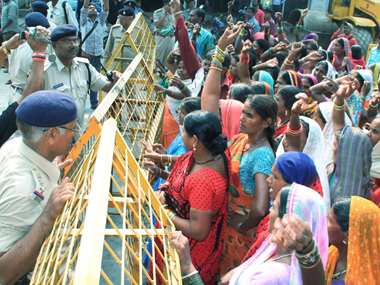The tragedy of eight women dying in Chhattisgarh in a messed-up sterilisation campaign should prompt a rethink on who should be doing the cut more often: men or women? While it goes without saying that sterilisation camps ought to be supervised better and made safer for all patients, the fact that more women than men opt for sterilisation is a pointer to how badly skewed the risks are against women. According to this Times of India report, 98 percent of the 4.2 million sterilisation operations in India were done on women. This is shocking, and shows that the male half of coupledom is not doing enough when they decide to opt for this permanent form of birth control. [caption id=“attachment_1799253” align=“alignleft” width=“380” class=" “]  Women protesting against the deaths in Chhattisgarh.[/caption] One can speculate why this is so: one reason could be that the bitter memories from the Sanjay Gandhi campaign of forced sterilisations in 1975-76 during the infamous emergency have not receded. But that was 38 years ago. One-and-a-half generations of men have been born after that to still think of that as trauma. The other – and more likely reason – could be that men are still too obsessed by false fears about losing libido or virility if they undergo sterilisation. The state has not done enough to ensure buy-in from men. As a result, women have borne an unfair share of the burden in preventing conception. In a sense, this has been the case all the time. The first birth control techniques targeted women (pills, etc) because it was felt that stopping a egg or two from getting fertilised was easier than preventing millions of sperm from made a dash for it through the use of condoms. But in India, the state has always believed that offering permanent birth prevention options was better than just trying to promote daily-use condoms or spermicides as these were not foolproof. Before we go further we need to understand what male or female sterilisations are all about. (Read some explanations here) The male sterilisation technique is vasectomy, where the doctor either cuts or ties up the tube that carries sperm from the testicles to the penis. In the female version, called tubectomy, it is the fallopian tubes (which carry the egg from the ovary to the womb) that need to be blocked. Both operations are about preventing Ms Egg or Mr Sperm from ever meeting up to consider the creation of a new life. Broadly speaking, neither operation is too complicated, if done by professionals in clean surroundings. In fact, the vasectomy can be done with local anaesthesia, while the tubectomy often needs general anaesthesia. Some vasectomies can apparently be done even without stitches; tubectomies need at least four stitches. This means, in general, tubectomies need more effort and care than vasectomies, and the complications can also be more than in the case of male surgeries. (Read this informative blog on who should do it). If this is the case, the proportion of vasectomies should be much higher than tubectomies since it is both easier and less risky. The massive excess of tubectomies over vasectomies in India is thus one more evidence of a patriarchal mindset prevailing. Government ought to promote male sterilisations more than female. Purely from a male point of view, allowing this to happen is unchivalrous. If you are going to let your spouse or partner take more risks in an operation than you would yourself, you are not half the man you think you are. It is time men stepped up to the plate – or, rather, the surgical table – when they along with their spouses decide enough is enough.
More women opt for sterilisation as a form of permanent birth control technique than men, even though the operations are simpler in the case of men.
Advertisement
End of Article
Written by R Jagannathan
R Jagannathan is the Editor-in-Chief of Firstpost. see more


)
)
)
)
)
)
)
)
)



